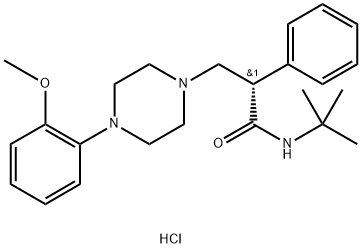(s)-way 100135 dihydrochloride is a potent and selective antagonist of 5-ht1a receptor with ic50 value of 15 nm.the 5-ht1a receptor is a g protein-coupled receptor for endogenous neurotransmitter serotonin (5-ht) and mediates inhibitory neurotransmission.(s)-way 100135 dihydrochloride is a potent and selective somatodendritic and postsynaptic 5-ht1a receptors antagonist. (+/-)-way100135 inhibited 5-ht1a receptor in the rat hippocampal with ic50 value of 34 nm [1].in the murine elevated plus-maze test, (s)-way 100135 (10 mg/kg) exhibited anxiolytic-like effects [2]. in free feeding rats, way-100135 (3 mg/kg) significantly inhibited hyperphagia and the increased incidence of feeding induced by 8-oh-dpat (0.1 mg/kg), which was mediated by somatodendritic 5-ht1a autoreceptor [3]. in rats, (s)-way 100135 (0.2, 1, 5 ug/ul) inhibited the impairment of choice accuracy induced by intrahippocampal scopolamine (3.75 ug/ul) in a dose-dependent way. however, (s)-way 100135 didn’t influence the acquisition of spatial learning [4]. in rats, way-100135 (10.0 mg/kg) inhibited the decrease of 5-ht release induced by buspirone, a 5-ht1a receptor partial agonist [5].
[1]. fletcher a, bill dj, bill sj, et al. way100135: a novel, selective antagonist at presynaptic and postsynaptic 5-ht1a receptors. eur j pharmacol, 1993, 237(2-3): 283-291.
[2]. rodgers rj, cole jc. anxiolytic-like effect of (s)-way 100135, a 5-ht1a receptor antagonist, in the murine elevated plus-maze test. eur j pharmacol, 1994, 261(3): 321-325.
[3]. hartley je, fletcher a. the effects of way-100135 and 8-hydroxy-2-(di-n-propylamino)tetralin on feeding in the rat. eur j pharmacol, 1994, 252(3): 329-332.
[4]. carli m, luschi r, samanin r. (s)-way 100135, a 5-ht1a receptor antagonist, prevents the impairment of spatial learning caused by intrahippocampal scopolamine. eur j pharmacol, 1995, 283(1-3): 133-139.
[5]. routledge c, gurling j, ashworth-preece ma, et al. differential effects of way-100135 on the decrease in 5-hydroxytryptamine release induced by buspirone and nan-190. eur j pharmacol, 1995, 276(3): 281-284.
